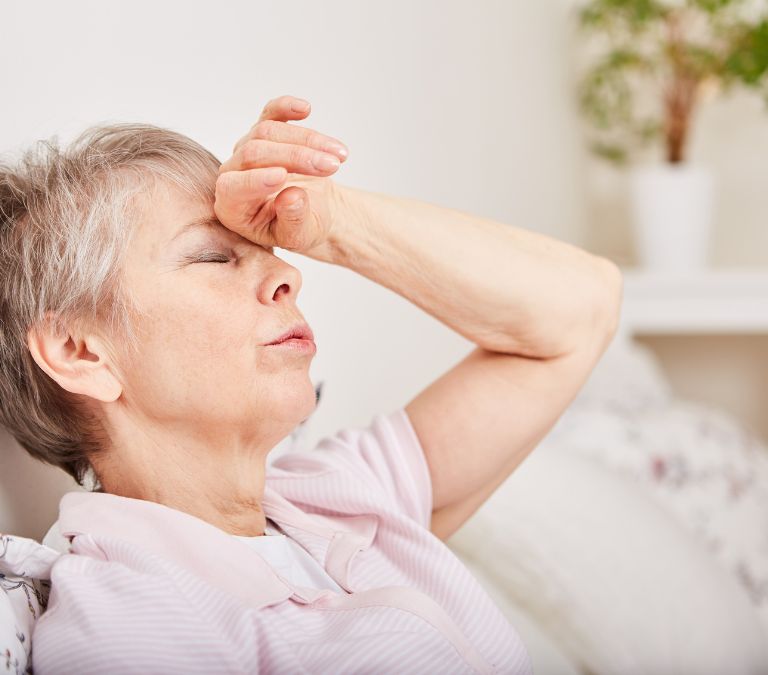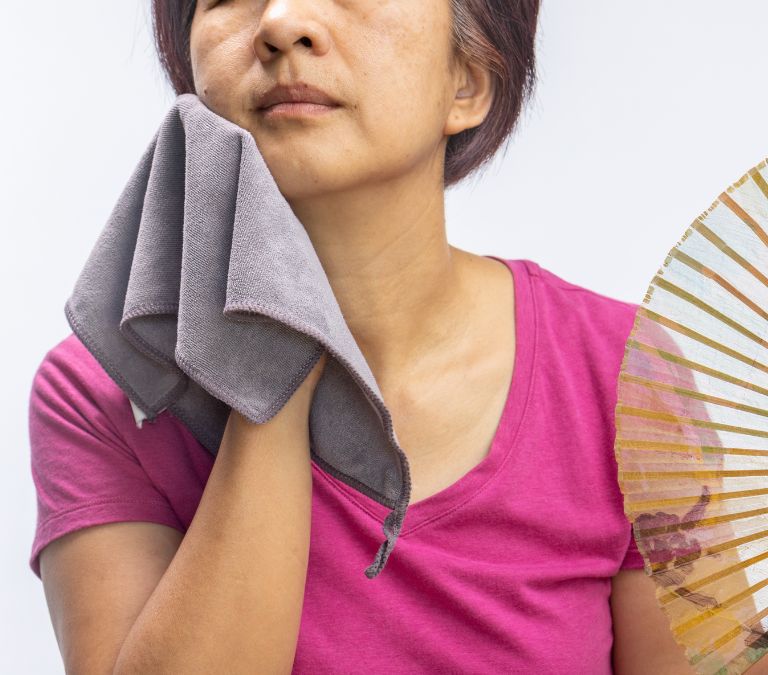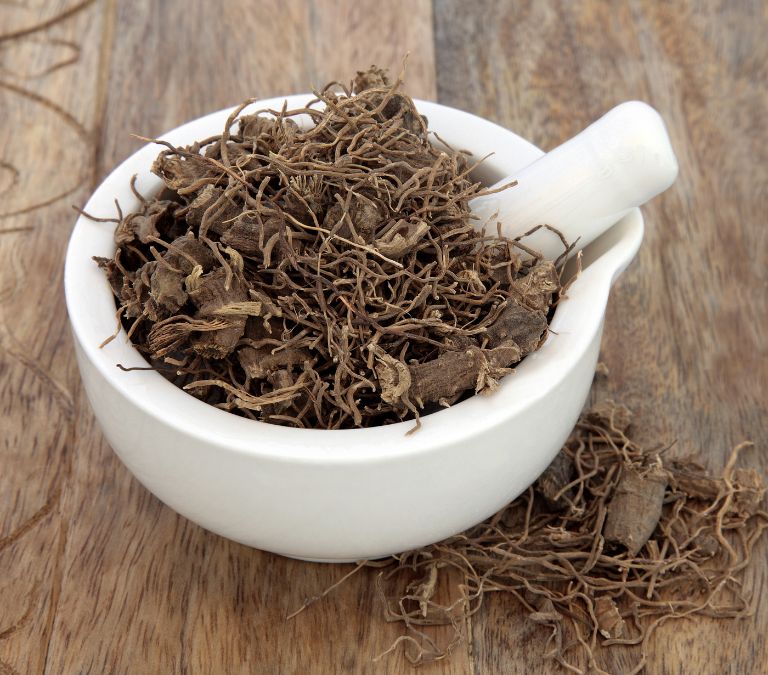A hot flash is a sudden and intense feeling of heat that causes profuse sweating and a flushed face. It occurs particularly in the upper body and is most intense in the face, neck, and chest, causing your fingers to tingle and your skin to redden as if you’re blushing. A hot flash is a symptom that occurs in approximately three-quarters of all women in perimenopause, which is the period before their actual menopause.
According to the North American Menopause Society, once a woman reaches menopause, she may continue to have hot flashes for 6 months to 5 years, and in some cases, for an even longer period. Hot flashes and night sweats are two of the most common symptoms of menopause. When hot flashes occur at night, they are called night sweats.
Because of the significant decrease in estrogen in menopausal women, central temperature-regulating control is lost in the woman’s body, hence the cause of hot flashes.
How Long Do Hot Flashes Last During Menopause?

The frequency and intensity of hot flashes vary among different women. A hot flash episode can last from 30 seconds to about 5 minutes. They may sometimes be mild or intense and disrupt your daily activities. Night sweats may keep you awake and cause long-term disruption to your sleep pattern. Some women may also experience hot flashes a few times per week, while others experience several flashes per hour.
What Causes Hot flashes?
It is not yet exactly clear what causes hot flashes. However, multiple studies and research have attempted to understand the cause of hot flashes. It is also clear that hot flashes mainly result from hormonal changes, especially during menopause. Research is also being made to understand the connection between hot flashes and other health problems, such as diabetes, obesity, and metabolic syndrome, which all tend to increase the incidence of hot flashes in women.
Research also suggests that hot flashes occur when your estrogen levels decrease and cause your body’s hypothalamus to become more sensitive to changes in body temperature. When your body’s thermostat, the hypothalamus, thinks your body temperature is too warm, it begins to cause hot flashes to cool down your body temperature.
Medical experts also suspect blood circulation to be a cause. The fluctuation in your hormone levels affects the blood flow in your body and causes your blood vessels to dilate. This causes a large amount of sweat to pour out of your body. Hot flashes are also sometimes experienced with increased heart rates and chills.
While some women barely experience hot flashes, others experience them for a long time or the rest of their lives, learning the appropriate steps to manage them.
Hot Flash Triggers
However, hot flashes have some triggers known to make them occur more frequently. Some of them include the following:
Hormonal Imbalance
During menopausal transitions, estrogen, the female hormone responsible for sexual activity, metabolism, and bone density, fluctuates and drops in amount. This drop and fluctuation in estrogen levels lead to many changes within your body. The hormones testosterone and cortisone – a hormone also involved in your body’s metabolism – drop, which results in frequent changes in body temperature. The frequency of changes in body temperature affects you and causes the resultant hot flashes.
Stress
Women under a lot of stress are more prone to frequent hot flashes. People with stress and anxiety are 3 to 5 times more likely to experience hot flashes. When you are stressed out, your body releases a hormone called cortisone.
Cortisone is responsible for metabolism by accelerating your heart rate and blood pressure. An increased heart rate and blood pressure cause future health problems, including hot flashes. Stressful emotions rush blood to the skin’s surface and trigger a hot flash. As a result, you may feel unexpectedly hot when you are filled with stress and anxiety or experiencing a panic attack.
To control stress and subsequent hot flashes, you can practice breathing exercises for 20 minutes every day, do some yoga, and stretches, and try as much as possible to avoid stressful situations.
Smoking
One of the most common triggers of hot flashes is smoking. Research shows that women who smoke are four times more likely to experience hot flashes than women who don’t smoke. Scientists concluded that cigarette smoking is associated with more frequent and severe hot flashes because the 250 harmful chemicals released from smoking decrease your already low estrogen levels. Smoking also attacks your nervous system.
Smoking is catastrophic for your body. Every puff of smoke inhaled also reduces your lung capacity. This makes hot flashes more unpleasant and severe.
When experiencing a hot flash, you need a lot of fresh air. Smoking does not allow you to breathe in enough fresh air as normally as you should, making it impossible to control your hot flash. With every puff of smoke, your next hot flash will be worse than the previous one. Many studies have found that smoking is directly linked to hot flashes. Women who smoke are 85% more likely to suffer from more severe hot flashes. Smoking generally causes a lot of diseases in your body and is best avoided.
Alcohol

Alcohol is one of the worst things you can ever do to your body during the menopausal transition. It usually causes dilation of your blood vessels and has a great heating effect on your body. Dilated blood vessels only worsen when you’re experiencing a hot flash. Drinking alcohol frequently affects your body temperature a lot.
When you drink alcohol, your brain cells tell your blood vessels to expand to eliminate the extra heat that the alcohol generates. Once the blood vessels expand, you begin to feel progressively warmer because of the increased blood flow in the blood vessels beneath your skin. Drinking alcohol also makes your estrogen levels fluctuate even more. This is one of the leading causes of hot flashes, so you may want to rethink the next beer,, tequila, or red wine.
One research survey revealed that women who drank alcohol daily were more likely to experience severe hot flashes and night sweats.
Another research shows that women who drank alcohol at least once a month were less likely to have hot flashes than women who abstained from alcohol completely. While it may be true that research has proven that sometimes, alcohol helps to reduce hot flashes, it is best to avoid it completely.
Spicy Foods
Like alcoholic drinks, spicy foods cause vasodilation of the blood vessels, contributing a lot to how hot flashes are triggered. Try eliminating spicy foods, especially dishes prepared with hot peppers and chili powders. Chilli peppers contain a chemical substance called capsaicin, which is responsible for their intense flavor.
This substance triggers a burning sensation in your body which worsens hot flashes. Eating spicy foods raises your body temperature unnecessarily. Dishes such as Indian, Thai, and Mexican foods should not be eaten regularly. It is best to eat spices that add flavor and not heat to your food, such as curry, basil, and cumin.
Sugary And Fatty Foods
Studies show that people who are overweight and obese have a higher chance of suffering from severe hot flashes than people within their normal weight range. Excess fat in your body not only worsens your menopausal symptoms but also worsens your hot flashes. This is why it’s important to maintain a healthy diet.
High blood sugar has been linked to hot flashes. Research shows that sugar impacts your blood levels. And since your sugar intake affects your blood sugar levels, it might also increase the intensity of your hot flashes. Your blood sugar levels can be affected by a number of things, including stress, lack of sleep, side effects from certain medications, and consumption of a diet high in saturated fats and sugar
Consumption of a diet high in saturated fats and sugar, such as fatty meats, processed sugars, baked goods, fruit juice, etc, leads to spikes in blood sugar levels, which can ultimately cause hot flashes. The glycemic index indicates that foods low on the index, such as vegetables, some fruits, whole grains, and nuts, help to stabilize blood sugar levels. It is beneficial to fill your plate with the right food and limit sugary and fatty foods from your diet as much as possible.
Caffeine
Unlike alcohol and spicy foods, caffeine narrows your blood vessels instead of widening them. It is referred to as a vasoconstrictor. However, in some women, it can have the same effect as alcohol and spicy foods, which widen your blood vessels, triggering a hot flash.
This process occurs because caffeine slightly raises your heart rate, which increases the speed at which your heart pumps blood through your body. This may raise the body temperature and cause the skin to flush. Studies have revealed an association between the consumption of caffeine and the occurrence of hot flashes in perimenopausal and postmenopausal women. A quick and easy fix is to drink more herbal teas and take cool decaffeinated coffee.
Signs Of Hot Flashes In Perimenopause

Perimenopause is the period before your menopause begins, during which your body begins to make the natural transition to menopause, which is the end of your reproductive years. Perimenopause is also called the menopausal transition.
During perimenopause, the level of estrogen, which is the female sex hormone, begins to depreciate. Then, the woman begins to experience menopausal symptoms, such as hot flashes, weight gain, and irregular periods. Perimenopause can last for several years. Once your body has gone through 12 consecutive months without seeing your period, you know that menopause has started for you. Different women begin perimenopause at different ages, depending on their bodies. The estrogen level fluctuates during perimenopause, and causes symptoms like hot flashes, sleep deprivation, and vaginal dryness.
Hot flashes are one of the major symptoms of perimenopause. These hot flashes typically begin in the scalp, face, neck, and chest. Hot flashes cause the women to feel warm and tingly, especially in the upper parts of their body and cause profuse sweating. Hot flashes often occur for about a year or two after menopause. Here are a few signs of hot flashes during perimenopause: a sudden feeling of warmth or heat that spreads through the face, neck, and chest; a flushed appearance with red blotchy skin; rapid heartbeat; a sudden change in body temperature; profuse sweating; feeling of anxiety; and finally, a sudden chill as the hot flash lets up.
How To Reduce The Frequency Of Hot Flashes
Once hot flashes have started, it isn’t easy to end. However, it does not mean it is impossible to manage hot flashes to make them less frequent and intense. There are a few ways to ensure that you properly manage your hot flashes:
Avoid Hot Flash Triggers
It is important to make certain lifestyle modifications and end things that may trigger your hot flashes or even deteriorate your health. Avoid triggers such as caffeine, alcohol, smoking, and spicy foods, fatty foods. Necessary changes such as regular exercise and practicing taking slow and deep can help relieve hot flashes. Take steady, slow, and deep breaths whenever you feel a hot flash coming on.
If your hot flash is triggered by stress or anxiety, try to lower your stress levels by taking deep breaths, meditating, doing some yoga stretches, going on a walk, doing hypnotherapy sleep sessions, or any other stress-reducing technique.
Be conscious of anything that triggers your hot flashes, and try as much as possible to avoid them. Some people may have noticed that their hot flashes are triggered by certain foods, drinks, places, or events.
It is also important to wear thin, loose-fitting clothing to bed and ensure that your room temperature is not too warm, especially at night.
Relax
Stress causes the release of a chemical substance called epinephrine, which increases body temperature and causes sweating. Carrying out relaxing activities may help reduce the severity and frequency of hot flashes. You can do some activities to promote relaxation and calmness of your mind, such as meditation and mindfulness yoga.
One highly recommended activity for relaxation is hypnotherapy. Many women report that hypnotherapy has helped them feel calm and reduce anxiety and stress, which are key triggers for hot flashes. Studies have also shown that hypnotherapy reduces hot flashes in women by 80%, making it more effective to manage hot flashes.
When you experience an incidence of hot flashes, your sympathetic nervous system, also known as the ‘fight or flight’ setting in your body, is triggered. However, what hypnotherapy does is that it engages your parasympathetic nervous system, which controls your rest. This slows your heart rate, relaxes your muscles, and helps you stay calm.
A hypnotherapy session can be done in person with a qualified therapist or in the comfort of your home. During the sessions, you’ll be made to practice several relaxation exercises that help your mind remain focused and helps you pay maximum attention. When you’re in this completely relaxed state, you’ll be made to listen to cooling suggestions about how your body manages hot flashes, which progressively reduces your anxiety or stress.
During a session, you’ll be taken through relaxation exercises, and while your body relaxes, your mind will retain a focused state of attention. When you’re in this state, you’ll listen to cooling visualizations and suggestions about how your body will manage hot flashes and how they will bother you less and less.
Hypnotherapy not only helps your body learn the art of relaxation, but it also helps your brain adjust how it responds to normal temperatures, which helps with the reduction and intensity of hot flashes.
After practicing, some people can take the relaxation techniques learned from their hypnotherapy sessions and apply these techniques when they are in situations that may trigger a hot flash. This process is called self-hypnosis and can slow down the events that typically lead to a hot flash, such as increased heart rate and body temperature.
You may also want to consider making certain changes and learn to prioritize your health.
Get Enough Sleep
Good sleep is very important, but unfortunately, many women experience hot flashes known as night sweats. This messes up their sleep patterns and sometimes causes severe sleep deprivation. Lack of quality causes fatigue, anxiety, stress, and sometimes, even high blood pressure. Not only do these affect your overall health, but they also intensify the frequency and severity of your hot flashes.
Your night sweats cause sleep disruption leading to fatigue and exacerbating stress levels. It is, therefore, important to put structures in place to help you get good quality sleep. It is advisable that you: avoid caffeine, alcohol, and hot drinks before going to bed; wear thin or loose-fitting clothing to bed; make sure to keep an ambient room temperature; and live healthier.
Don’t Cool Yourself
Most people feel the intense urge to do anything possible to cool themselves down while experiencing a hot flash. One of the biggest hot flash myths is that you can cool yourself during a hot flash with fans, water sprays, and cold drinks.
With hot flashes, while you experience sudden heat sensations that make you feel like your body is overheating, it is not true. The hot feelings you get during a hot flash are created by your hypothalamus, also called the body’s thermostat, to cool you down. So instead of futile attempts to cool yourself during a hot flash, keeping a consistently ambient room temperature would be better to avoid temperature fluctuations that may trigger your hot flashes.
Drink Plenty Of Water
Replace your alcohol and caffeine intake with lots of water instead. Water helps to improve your body temperature and blood circulation,, which helps reduce hot flashes.
Medical Treatment Of Hot Flashes
Hormone Therapy Replacement
Hot flashes have been treated with oral or transdermal form estrogen. Hormone Replacement Therapy (HRT), now referred to as Hormone Therapy (HT) or Postmenopausal Hormone Therapy (PHT), involves the synthetic administration of the hormone estrogen, or a combination of both female hormones, estrogen, and progesterone. Hormone therapy is carried out to replace a woman’s depleting hormone levels that cause menopausal symptoms.
The process balances the levels of estrogen and progesterone in the body and is very effective for treating hot flashes. It replaces the hormones that are at lower levels in the body. It also helps with other menopausal symptoms like bone density, vaginal dryness, and fatigue.
Hormone replacement therapy is not exactly suitable for everyone, so it is advisable to speak to your doctor to know whether the treatment is right for your body before you start this therapy and also to gain a proper understanding of its benefits risks. Research has proven that all estrogen medications – oral or transdermal – effectively reduce the frequency and severity of hot flashes.
However, Hormone Therapy has been linked to various risks such that there are debates on its ratio of benefits and risks. Studies carried out by the Women’s Health Initiative (WHI) on women who received combined hormone therapy were discovered to have an increased risk of getting a heart attack, stroke, and breast cancer. On estrogen therapy, postmenopausal women developed an increased risk of endometrial cancer (cancer of the uterine lining). Despite these risks, Hormone Replacement Therapy is a great way to medically control your hot flashes. It is recommended that women who opt for hormone therapies should take the lowest doses within the shortest time.
Bio-identical Hormone Therapy
Traditional hormone replacement therapies use synthetically produced versions of the female sex hormones – estrogen and progesterone.
Bio-identical hormones are artificial hormones derived from plant hormones that are chemically identical to the hormones produced by the human body. Estrogen, progesterone, and testosterone are the most common replicates used in treating hormonal imbalances. Bio-identical hormone medications copy human hormones such as estrogen, estriol ( a weak estrogen), and progesterone.
The US Food and Drug Administration has approved manufacturing some forms of bio-identical hormones, including bio-identical estriol and progesterone. However, the FDA has not approved custom compounded bio-identicals because they are not considered safe.
Bio-identical hormones come in various forms, such as pills, injections, creams, gels, and patches. It is important to note that all plant-based products should be taken with utmost care because the FDA does not regulate them, and some herbs have been found to interfere with blood pressure.
Other Drug Prescriptions For Treating Hot Flashes
Over-the-counter supplements, lifestyle adjustments, and mind-body treatments sometimes help with menopausal symptoms, including hot flashes. It is important to note that all the medication listed are to be used only because you have seen your doctor, and he prescribes these to you.
-
Selective serotonin reuptake inhibitor (SSRI) medications have been proven to be greatly effective in reducing hot flashes during the menopausal transition of women These drugs are usually used in the treatment of depression, anxiety, and severe stress. Paroxetine also known as Brisdelle is an SSRI that has been approved to treat moderate to severe hot flashes during menopause.
-
A Stellate Ganglion Blockade (SGB) is a local anesthetic injected into your neck. This injection helps to turn off certain nerves that regulate your body temperature. According to the International Menopause Society, SGB is potent enough to reduce hot flashes and night sweats by 50% over a period of several months. Studies also show that it is safe and well-tolerated in most people’s bodies without any adverse effects.
-
Clonidine, also known as Catapres is an anti-hypertensive drug that relieves hot flashes in some women. Clonidine usually comes in pills or as a skin patch and helps to decrease blood pressure. However, clonidine has side effects including constipation, dry mouth, drowsiness, or difficulty sleeping.
-
Megestrol acetate (Megace) is a progestin that is sometimes prescribed to relieve menopausal women of hot flashes over a short period. This drug is usually not prescribed as a first-line treatment for hot flashes. Severe side effects can occur if this drug is abruptly discontinued. Megestrol may also cause weight gain.
-
Medroxyprogesterone acetate, also referred to as Depo-Provera, is another progestin drug injected into the body to treat hot flashes.
Natural Remedies For Hot Flashes
Some women use natural herbal therapies to treat and manage their hot flashes. These alternative therapies include black cohosh, soy, phytoestrogen, and vitamin E.
Black Cohosh

Black cohosh is a herbal preparation that is becoming increasingly popular in the U.S. and is Northe th American Menopause Society’s support for short-term use for treating menopausal symptoms in women. It is recommended to be used for about six months because of the incidence – however low – of side effects.
Research has revealed that black cohosh can be effective in the reduction of hot flashes. Studies have shown that taking daily doses of 6.5 to 160 mg of black cohosh for about a year improves menopausal symptoms, including hot flashes. However, these studies have not established black cohosh’s scientific long-term benefits and safety.
Black cohosh interferes with the working of many prescribed medications and is not advisable to be used simultaneously with other herbs. Women should consult with their doctors before using black cohosh. Despite this, some women have reported that black cohosh helped them with their symptoms.
Phytoestrogen
Many plants contain a compound called phytoestrogen; a chemical compound called dietary estrogens. In simple terms, phytoestrogen is a plant-based estrogen. Phytoestrogens are capable of binding themselves to the human estrogen receptors. These plant-based estrogens help women by increasing the amount and effectiveness of estrogen in women transitioning into menopause. It may be taken as pills or eaten. Phytoestrogen is commonly found in legumes, seeds, and whole grains such as flax and sesame seeds.
Soy
Soy contains a type of phytoestrogen called isoflavone, the most studied plant estrogen. Studies have shown that soy is effective when it comes to the treatment of hot flashes and other menopausal symptoms.
Women who have had breast cancer and cannot take Hormone Replacement Therapy with estrogen turn to beatings to get relief from hot flashes. Soy has a physiological effect similar to estrogen and should not be taken by women who have gone through hormone therapy or by women at risk of breast cancer.
Licorice Root
A study conducted in 2012 revealed that women who take 330 milligrams of licorice root extract three times daily for at least eight weeks had reduced the frequency and severity of their hot flashes. This root also contains phytoestrogen.
Valerian Root
Studies revealed that women who took 255mg of valerian root extract three times a day for at least weeks could reduce the frequency of their hot flashes. Valerian also contains phytoestrogen and can influence the activity of serotonin and help improve sleep.
Evening Primrose Oil
Evening Primrose oil is made from the seeds of the evening primrose plant. It contains certain essential fatty acids, which are functional in promoting body health. The evening primrose is a historical plant used to relieve several health issues. It has also been promoted to greatly relieve hot flashes. Reported side effects of the evening primrose oil include inflammation, nausea, diarrhea, and causes problems with blood clotting. It should be noted that this plant is not to be taken with anticoagulants or phenothiazines, a psychotherapeutic agent.






